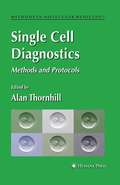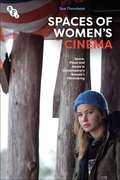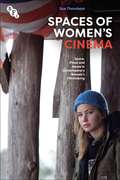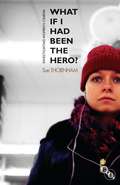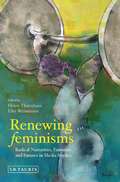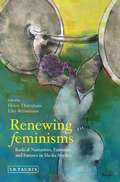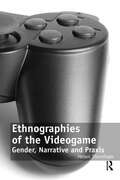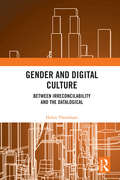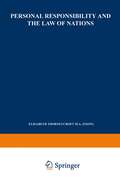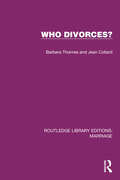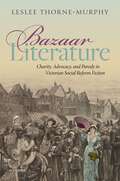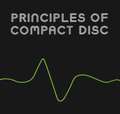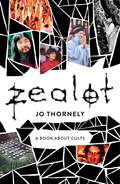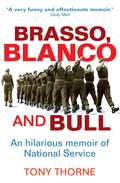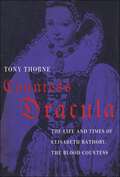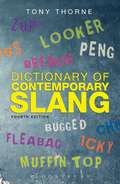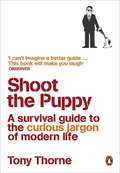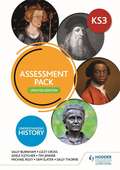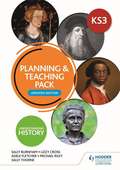- Table View
- List View
Single Cell Diagnostics: Methods and Protocols (Methods in Molecular Medicine #132)
by Alan ThornhillThis book applies modern molecular diagnostic techniques to the analysis of single cells, small numbers of cells, or cell extracts. Emphasis is placed on non-invasive analysis of single cell metabolites and the direct analysis of RNA and DNA from single cells, with a focus on polymerase chain reaction and fluorescence in situ hybridization. In particular, this handbook is essential for practitioners providing care for couples seeking treatment for infertility.
Spaces of Women's Cinema: Space, Place and Genre in Contemporary Women’s Filmmaking
by Sue ThornhamSue Thornham explores issues of space, place, time and gender in feminist filmmaking through an examination of a wide range of films by contemporary women filmmakers, ranging from the avant-garde to mainstream Hollywood. Beginning from questions about space itself and the way it has been gendered, she asks how representation functions in relation to space and time, and how this, too, is gendered, before moving to an exploration of how such questions might be considered in relation to women's filmmaking. In sections dealing with spaces from wilderness to city, she analyses in detail how these issues have been dealt with by women filmmakers, addressing the work of filmmakers such as Jane Campion, Kathryn Bigelow, Julie Dash, Maggie Greenwald, Patricia Rozema and Carol Morley, and films including 'An Angel at My Table' (1990), 'Daughters of the Dust' (1991) 'The Ballad of Little Jo' (1993), 'Winter's Bone' (2010), 'Zero Dark Thirty' (2012) and 'The Falling' (2014).
Spaces of Women's Cinema: Space, Place and Genre in Contemporary Women’s Filmmaking
by Sue ThornhamSue Thornham explores issues of space, place, time and gender in feminist filmmaking through an examination of a wide range of films by contemporary women filmmakers, ranging from the avant-garde to mainstream Hollywood. Beginning from questions about space itself and the way it has been gendered, she asks how representation functions in relation to space and time, and how this, too, is gendered, before moving to an exploration of how such questions might be considered in relation to women's filmmaking. In sections dealing with spaces from wilderness to city, she analyses in detail how these issues have been dealt with by women filmmakers, addressing the work of filmmakers such as Jane Campion, Kathryn Bigelow, Julie Dash, Maggie Greenwald, Patricia Rozema and Carol Morley, and films including 'An Angel at My Table' (1990), 'Daughters of the Dust' (1991) 'The Ballad of Little Jo' (1993), 'Winter's Bone' (2010), 'Zero Dark Thirty' (2012) and 'The Falling' (2014).
What If I Had Been the Hero?: Investigating Women's Cinema
by Sue ThornhamSue Thornham's study explores issues in feminist filmmaking through an examination of a wide range of films by women filmmakers, ranging from the avant-garde to mainstream Hollywood, and from the 1970s to the present day, discussing directors including Sally Potter, Jane Campion, Julie Dash, Patricia Rozema and Lynne Ramsay.
What If I Had Been the Hero?: Investigating Women's Cinema
by Sue ThornhamSue Thornham's study explores issues in feminist filmmaking through an examination of a wide range of films by women filmmakers, ranging from the avant-garde to mainstream Hollywood, and from the 1970s to the present day, discussing directors including Sally Potter, Jane Campion, Julie Dash, Patricia Rozema and Lynne Ramsay.
Renewing Feminisms: Radical Narratives, Fantasies and Futures in Media Studies
by Helen Thornham Elke WeissmannThe feminist movement, we have been told, is history. This lively book reveals that on the contrary the feminist movement is alive and kicking, still as engaged with the concerns and ways of seeing as it was in the 1960s, 70s and 80s, still demanding its political place. Renewing Feminisms sets out the claim for a feminism that is renewed, re-invigorated and re-imagined. Renewing Feminisms offers a timely contribution to current debates about lived and imagined feminism today. The contributors, both longstanding feminists and emerging feminist scholars, take a fresh look at feminist critiques and methodologies, recalling the power of past feminist interventions, as well as presenting a new call for future initiatives in media and cultural studies. Re-investigating the past facilitates a claim over the future, and all the contributions to this book make clear that feminism is not only far from over, it is lived and experienced in the everyday, and on personal and political levels.Divided into four key sections, the book revisits major feminist areas, investigating representational issues, those of agency and narrative, media forms and formats, and the traditional boundaries of the public and the private. What emerges is a real intervention into media and cultural studies in terms of how we understand them today.
Renewing Feminisms: Radical Narratives, Fantasies and Futures in Media Studies
by Helen Thornham Elke WeissmannThe feminist movement, we have been told, is history. This lively book proposes that on the contrary the feminist movement is alive and kicking, still as engaged with the concerns and ways of seeing as it was in the 1960s, '70s and '80s; still demanding its political place. Renewing Feminisms sets out the claim for a feminism that is renewed, reinvigorated and re-imagined.The book offers a timely contribution to current debates about lived and imagined feminism today. The contributors, both longstanding feminists and emerging feminist scholars, take a fresh look at feminist critiques and methodologies, recalling the power of past feminist interventions, as well as presenting a new call for future initiatives in media and cultural studies. They revisit major feminist areas, investigating representational issues, those of agency and narrative, media forms and formats, and the traditional boundaries of the public and the private. What emerges is a real intervention into media and cultural studies in terms of how we understand them today.
Ethnographies of the Videogame: Gender, Narrative and Praxis
by Helen ThornhamEthnographies of the Videogame uses the medium of the videogame to explore wider significant sociological issues around new media, interaction, identity, performance, memory and mediation. Addressing questions of how we interpret, mediate and use media texts, particularly in the face of claims about the power of new media to continuously shift the parameters of lived experience, gaming is employed as a 'tool' through which we can understand the gendered and socio-culturally constructed phenomenon of our everyday engagement with media. The book is particularly concerned with issues of agency and power, identifying strong correlations between perceptions of gaming and actual gaming practices, as well as the reinforcement, through gaming, of established (gendered, sexed, and classed) power relationships within households. As such, it reveals the manner in which existing relations re-emerge through engagement with new technology. Offering an empirically grounded understanding of what goes on when we mediate technology and media in our everyday lives Ethnographies of the Videogame is more than a timely intervention into game studies. It provides pertinent and reflexive commentary on the relationship between text and audience, highlighting the relationships of gender and power in gaming practice. As such, it will appeal to scholars interested in media and new media, gender and class, and the sociology of leisure.
Ethnographies of the Videogame: Gender, Narrative and Praxis
by Helen ThornhamEthnographies of the Videogame uses the medium of the videogame to explore wider significant sociological issues around new media, interaction, identity, performance, memory and mediation. Addressing questions of how we interpret, mediate and use media texts, particularly in the face of claims about the power of new media to continuously shift the parameters of lived experience, gaming is employed as a 'tool' through which we can understand the gendered and socio-culturally constructed phenomenon of our everyday engagement with media. The book is particularly concerned with issues of agency and power, identifying strong correlations between perceptions of gaming and actual gaming practices, as well as the reinforcement, through gaming, of established (gendered, sexed, and classed) power relationships within households. As such, it reveals the manner in which existing relations re-emerge through engagement with new technology. Offering an empirically grounded understanding of what goes on when we mediate technology and media in our everyday lives Ethnographies of the Videogame is more than a timely intervention into game studies. It provides pertinent and reflexive commentary on the relationship between text and audience, highlighting the relationships of gender and power in gaming practice. As such, it will appeal to scholars interested in media and new media, gender and class, and the sociology of leisure.
Gender and Digital Culture: Between Irreconcilability and the Datalogical
by Helen ThornhamGender and Digital Culture offers a unique contribution to the theoretical and methodological understandings of digital technology as inherently gendered and classed. The silences within, through and from the systems we experience every day, create inequalities that are deeply affective and constitute very real forms of algorithmic vulnerability. The book explores these lived and mundane algorithmic vulnerabilities across three interrelated research projects. These focus on recent digital phenomena including sexting, selfies and wearables, and particular decision-making systems used in health, education and social services. Central to this book are the themes of irreconcilability and the datalogical. It makes the case that feminism and gender politics have become increasingly irreconcilable with not only long-running debates around representation and embodiment, but also with conceptions of the technological, conceptions of the user and of the systems themselves. In keeping with longstanding feminist scholarship, these irreconcilabilities can be productive and generative; they can be used to interrogate the power politics of digital culture. By studying the lived and routine elements of digital technologies, Gender and Digital Culture asks about the many convolutions that are held together through the everyday use of these technologies, and the implications for how gender and technology are approached, discussed and theorised.
Gender and Digital Culture: Between Irreconcilability and the Datalogical
by Helen ThornhamGender and Digital Culture offers a unique contribution to the theoretical and methodological understandings of digital technology as inherently gendered and classed. The silences within, through and from the systems we experience every day, create inequalities that are deeply affective and constitute very real forms of algorithmic vulnerability. The book explores these lived and mundane algorithmic vulnerabilities across three interrelated research projects. These focus on recent digital phenomena including sexting, selfies and wearables, and particular decision-making systems used in health, education and social services. Central to this book are the themes of irreconcilability and the datalogical. It makes the case that feminism and gender politics have become increasingly irreconcilable with not only long-running debates around representation and embodiment, but also with conceptions of the technological, conceptions of the user and of the systems themselves. In keeping with longstanding feminist scholarship, these irreconcilabilities can be productive and generative; they can be used to interrogate the power politics of digital culture. By studying the lived and routine elements of digital technologies, Gender and Digital Culture asks about the many convolutions that are held together through the everyday use of these technologies, and the implications for how gender and technology are approached, discussed and theorised.
Who Divorces? (Routledge Library Editions: Marriage)
by Barbara Thornes Jean CollardThe divorce rate in England and Wales increased nearly four-fold between 1950 and 1976; in the five years following the implementation of the 1969 Divorce Reform Act in January 1971, it more than doubled. Despite the plethora of public comment about the rising divorce rates, there was at the time very little objective data in our society about either those who chose to resolve their marital unhappiness by divorce, or the possible causes and consequences of such divorce. Originally published in 1979, this book, the first published study from the Marriage Research Centre, represented an important landmark in a relatively unexplored field. Who Divorces? Presents the findings of a large-scale study into the characteristics of those who divorce. Certain childhood, adolescent, pre-marital and marital characteristics and experiences of a random sample of men and women who divorced are considered and compared with the characteristics and experiences of a random sample of men and women whose marriages were still intact. Additionally, research findings relating to the causes and consequences of divorce, both for the individual and for society, are discussed with particular reference to the wide range of prevailing opinion on these matters.
Who Divorces? (Routledge Library Editions: Marriage)
by Barbara Thornes Jean CollardThe divorce rate in England and Wales increased nearly four-fold between 1950 and 1976; in the five years following the implementation of the 1969 Divorce Reform Act in January 1971, it more than doubled. Despite the plethora of public comment about the rising divorce rates, there was at the time very little objective data in our society about either those who chose to resolve their marital unhappiness by divorce, or the possible causes and consequences of such divorce. Originally published in 1979, this book, the first published study from the Marriage Research Centre, represented an important landmark in a relatively unexplored field. Who Divorces? Presents the findings of a large-scale study into the characteristics of those who divorce. Certain childhood, adolescent, pre-marital and marital characteristics and experiences of a random sample of men and women who divorced are considered and compared with the characteristics and experiences of a random sample of men and women whose marriages were still intact. Additionally, research findings relating to the causes and consequences of divorce, both for the individual and for society, are discussed with particular reference to the wide range of prevailing opinion on these matters.
Bazaar Literature: Charity, Advocacy, and Parody in Victorian Social Reform Fiction
by Leslee Thorne-MurphyBazaar Literature reorients our understanding of Victorian social reform fiction by reading it in light of the copious amount of literature generated for charity bazaars. Bazaars were ubiquitous during the nineteenth century, part of the vibrant and massive private sector response to a rapidly industrializing society. Typically organized and run by women, charity bazaars were often called "fancy fairs" since they specialized in ladies' hand-crafted "fancy" work. Indeed, they were a key method women used to intervene in political, social, and cultural affairs. Yet their conventional purpose—to raise money for charity—has led to their being widely overlooked and misunderstood. Bazaar Literature remedies these misconceptions by demonstrating how the literature written in conjunction with bazaars shaped the social, political, and literary movements of its time. This study draws upon a wide variety of texts printed to be sold at bazaars, including literature by Robert Louis Stevenson, Harriet Martineau, and Elizabeth Barrett Browning, alongside fictional depictions of fancy fairs by Charlotte Yonge, George Eliot, Frances Trollope, and Anthony Trollope. The book revises our understanding of the larger literary market in social reform fiction, revealing a parodic, self-critical strain that is paradoxically braided with strident political activism and its realist sensibilities.
Bazaar Literature: Charity, Advocacy, and Parody in Victorian Social Reform Fiction
by Leslee Thorne-MurphyBazaar Literature reorients our understanding of Victorian social reform fiction by reading it in light of the copious amount of literature generated for charity bazaars. Bazaars were ubiquitous during the nineteenth century, part of the vibrant and massive private sector response to a rapidly industrializing society. Typically organized and run by women, charity bazaars were often called "fancy fairs" since they specialized in ladies' hand-crafted "fancy" work. Indeed, they were a key method women used to intervene in political, social, and cultural affairs. Yet their conventional purpose—to raise money for charity—has led to their being widely overlooked and misunderstood. Bazaar Literature remedies these misconceptions by demonstrating how the literature written in conjunction with bazaars shaped the social, political, and literary movements of its time. This study draws upon a wide variety of texts printed to be sold at bazaars, including literature by Robert Louis Stevenson, Harriet Martineau, and Elizabeth Barrett Browning, alongside fictional depictions of fancy fairs by Charlotte Yonge, George Eliot, Frances Trollope, and Anthony Trollope. The book revises our understanding of the larger literary market in social reform fiction, revealing a parodic, self-critical strain that is paradoxically braided with strident political activism and its realist sensibilities.
Zealot: A book about cults
by Jo Thornely'a smart, daring and refreshing book.' - Weekend Australian 'deliciously sinister' - Herald SunWhy would anyone join a cult? Maybe they're unhappy with their current religion, or they want to change the world, or they're disappointed with their lives and want to find something bigger or holier that makes sense of this confusing, chaotic and dangerous world. Or maybe they just want to give themselves the best possible chance of having sex with aliens.Whatever the reason, once people are in, it's usually very difficult for them to leave. Cults have ways of making their followers do loopy, dangerous stuff to prove their loyalty, and in return they get a chance to feel secure within the cult's embrace, with an added bonus of being utterly terrified of the outside world. From the tragic JONESTOWN Kool-Aid drinkers to the Australian cult THE FAMILY to the fiery Waco climax of THE BRANCH DAVIDIANS, this book is a wide-sweeping look at cults around the world, from the host of the popular podcast ZEALOT.'a piss-taker of rare boldness.' - Weekend Australian
Brasso, Blanco and Bull: A Hilarious Memoir Of National Service
by Tony ThorneWhen Tony Thorne first turned up for his medical in 1956 he had little idea of the adventures he would face and the people he would encounter over the next two years in service. Brasso, Blanco & Bull is the hilarious account of life in National Service, where 23339788 Thorne faced the horrors of basic training, the boredom of the drill yard as well as the unforgettable camaraderie of the squad.Praise:'This book took me back more years than I care to remember.' Bernard Cribbins, The Parachute Regiment, 1947-8'A great reminder for those of us that did it and a great treat for those that didn't.' Windsor Davies, East Surrey Regiment, 1950-2'More Virgin Soldiers just like the ones I remember. This lot made me laugh a lot.' Leslie Thomas, Royal Army Pay Corps 1949-51'I thoroughly enjoyed the read.It took me back to my days of national service, most of which I enjoyed!'Freddie Truman, OBE, Royal Air Force 1951-3
Countess Dracula: The Life and Times of Elisabeth Bathory, the Blood Countess
by Tony ThorneThis is the story of Elisabeth Bathory, a 17th-century Transylvanian countess. She was tried as a vampire and became an inspiration for depraved murderers up to the present day.;Based on research conducted at archives in Eastern Europe, this account includes both the recorded truth and the legend that has grown up around her. Tony Thorne is the author of the "Bloomsbury Dictionary of Slang".
Dictionary of Contemporary Slang
by Tony ThorneWith more than 7,000 definitions, this book provides a definitive guide to the use of slang today. It deals with drugs, sport and contemporary society, as well as favourite slang topics such as sex and bodily functions. In this fully updated fourth edition of the highly acclaimed Dictionary of Contemporary Slang, language and culture expert Tony Thorne explores the ever-changing underworld of the English language, bringing back intriguing examples of eccentricity and irreverence from the linguistic front-line. "Thorne is a kind of slang detective, going down the streets where other lexicographers fear to tread." Daily Telegraph
Dictionary of Contemporary Slang
by Tony ThorneWith more than 7,000 definitions, this book provides a definitive guide to the use of slang today. It deals with drugs, sport and contemporary society, as well as favourite slang topics such as sex and bodily functions. In this fully updated fourth edition of the highly acclaimed Dictionary of Contemporary Slang, language and culture expert Tony Thorne explores the ever-changing underworld of the English language, bringing back intriguing examples of eccentricity and irreverence from the linguistic front-line. "Thorne is a kind of slang detective, going down the streets where other lexicographers fear to tread." Daily Telegraph
Shoot the Puppy: A Survival Guide to the Curious Jargon of Modern Life
by Tony ThorneAre you a bobo or a wombat? Are you tempted by infobia or to kick dead whales up the beach? If your answer to any of these questions is 'What are you talking about?', then you definitely need a copy of Shoot the Puppy. Amusing, informative and newly updated for 2007, it guides the reader through the ever-growing heap of contemporary jargon from around the English-speaking world, showing where it comes from, what it means, and what it tells us about our contemporary world.
Understanding History: Key Stage 3: Assessment Pack: Updated Edition
by Sally Thorne Lizzy Cross Sally Burnham Adele Fletcher Sam Slater Tim JennerSkilfully assess pupils' knowledge and skills, providing evidence of their achievement as they progress through the Understanding History course and build towards GCSE.> Monitor pupils' progress in their written work: indicative answers for the end-of-enquiry assessment tasks in the Student Book are annotated to show the features of a strong response and can be shared with pupils for peer/self-assessment> Check pupils' understanding regularly and flexibly: a baseline assessment, half-termly written tests and a bank of 600 knowledge check questions provide formative and summative assessment opportunities> Prepare students for the requirements of your GCSE specification: GCSE skills sheets based on the Student Book target specific skills that are assessed under the Pearson Edexcel, AQA and OCR B specifications
Understanding History: Key Stage 3: Planning & Teaching Pack: Updated Edition
by Sally Thorne Lizzy Cross Sally Burnham Adele FletcherDeliver an outstanding KS3 curriculum using this photocopiable pack of carefully sequenced lesson plans and activity worksheets for the Understanding History course.> Pick up and teach the course with ease: every lesson in the Student Book has a detailed lesson plan with learning outcomes, suggestions for stretch and challenge, a lesson starter, activities and a review/plenary that includes a low-stakes knowledge check and a deeper learning check> Support, build upon and go beyond the activities in the Student Book: 177 ready-made worksheets (at least one per lesson) help to develop pupils' knowledge, understanding, vocabulary and writing skills as they progress through the course> Use the Student Book flexibly for any length of KS3: the course planners provide an overview of how to teach the course in 6 or 9 terms, so those following a 3-year curriculum can incorporate their existing favourite lessons
